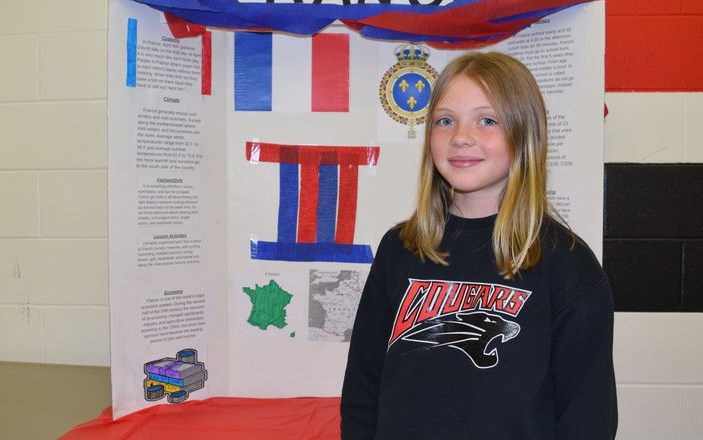Grade 6 students at Canora Composite School were given an assignment, to choose any country bordering on the Atlantic Ocean and then learn all about that country: food, sports, arts, fashion, literacy, currency, you name it.
Then, they shared their knowledge with parents and other invited family members during the International Bazaar held in the Canora Composite School gymnasium on June 14.
“They had the choice of working by themselves or in pairs,” said Jennifer Sleeva, teacher. “They had the opportunity to learn a lot, including just finding their country on a map. Studying other countries was especially significant after dealing with COVID-19, where we’ve all been so isolated from each other.”
France
Ryea Harper chose to work alone, and chose France for her project country.
“One thing that stood out to me was that in France students my age don’t go to school on Wednesdays, instead they go on Saturday morning,” said Harper. “A fun custom in France on April 1, instead of April Fools, they have April Fish Day. People go around trying to stick a paper fish on the backs of other people. If someone discovers a fish on their back, they have to yell out, ‘April Fish.’”
The biggest sport is in France is cycling, topped off by probably the best-known race across the globe; the Tour de France. It’s an annual men's multiple-stage bicycle race primarily held in France, while also occasionally passing through nearby countries. It consists of 21 stages, each a day long, over the course of 23 days
In addition to sports, other popular activities in France include: painting, sculpture, music, dance, and photography.
The French flag is blue, white and red, with each colour having special significance. Blue is for nobility, white is for clergy, and red signifies the bourgeois (middle class). Its origins are from the time of the French Revolution.
Harper concluded by adding “If I ever visit France, I’d love to see the Eiffel Tower, especially when it’s all lit up at night.
Brazil
Addison Dutchak and her partner Savannah Bryant chose to focus their project on the prominent –°¿∂ ”∆µ American country of Brazil. Unfortunately, Bryant was unable to attend the International Bazaar, but Dutchak was full of interesting knowledge to share with anyone who asked.
“Brazil’s national anthem is three minutes and 41 seconds long, the longest in –°¿∂ ”∆µ America,” she said. “The country’s first language is Portuguese. Their currency is the Real, but $1 in Real is only worth about 27 cents Canadian.”
Favourite leisure activities for Brazilians include soccer (football) and art. The main religion is Roman Catholic, and when church is over, Brazilians love food such as chilli, and yogurt with wheat and almonds.
If Dutchak ever finds herself in Brazil, she’d like to go surfing, hiking, and even try kite racing, which is apparently quite popular.
“I would like to paint there and also see first-hand their style of clothing, it’s very classy,” continued Dutchak. “I like that in Brazil, the men are possibly even more fashion-conscious than the women.”
Mexico
Mexico was the project country for Lucas Thompson and Owen Matychuk, who has actually been there.
They discovered that favourite foods for Mexicans include burritos, tacos and discada, which is full of meat and includes: sausage, chorizo, ground meat, ham, bacon, lard, jalapeno peppers and onions. It’s all seasoned with thyme, celery, cumin, oregano, bay leaf, black pepper, black sauces, salt, rosemary, a bit of dark beer, etc. The dish is cooked on a plow disc previously cured over some wood, hence the name.
“If I ever visit Mexico again, I’d like to go for Day of the Dead, which is from Oct. 31- Nov. 2 each year,” said Matychuk. “It’s held to connect with loved ones who have passed on, and at the same time celebrate more people coming into the world.”
Thompson shared that the most popular sports in Mexico are: wrestling, baseball, volleyball, jai-alai and soccer (football).
“If I get there sometime, I’d like to sit on the beach and get a tan,” he said with a smile. “I’d also like to kick a soccer ball around, and eat at an authentic Mexican restaurant."
Mexico’s main language is Spanish, English is secondary.
Fun fact: Mexican families often eat their main meal of the day before 4 p.m.
Nigeria
Tessica Mydonick and Mahra Collingridge presented their project on the African country of Nigeria at the International Bazaar.
“Over 500 languages are spoken in Nigeria,” said Mydonick. “Some people tend to switch from one language to another, even in the middle of a conversation. ‘Sannua’ means hello in Hausa, one of their most common languages.”
Nigeria’s population is over 216 million, compared to 37 million for Canada. But Canada is nearly 10 times larger than Nigeria in size.
"The standard of living in Nigeria is quite low, only about 50 per cent of the population can read and write,” added Collingridge. "Most families have no electricity.”
Favourite sports for Nigerians are: wrestling, boxing, swimming, soccer (football), and tennis.
Mydonick said she would like to play some tennis if she ever has the opportunity to spend any time in Nigeria.
“I would like to go there to help the poor and homeless, but also get to know them and have fun with them,” shared Collingridge
One of the most popular Nigerian events is the Farawa, somewhat similar to a powwow. It includes the reading of the first several verses of the book of Genesis from the Bible. About 40 per cent of Nigerians are Christians.




